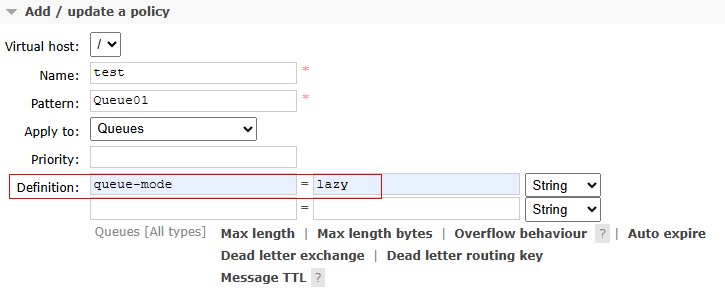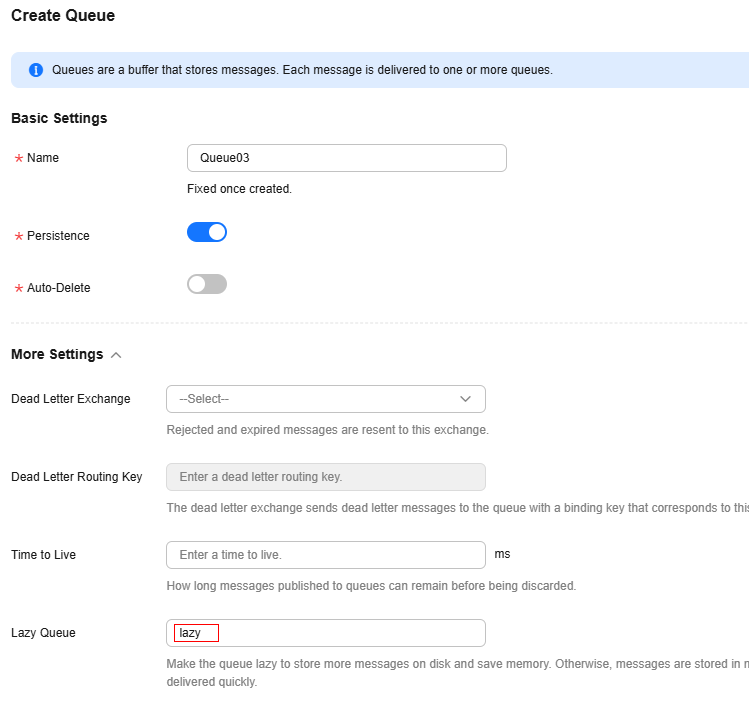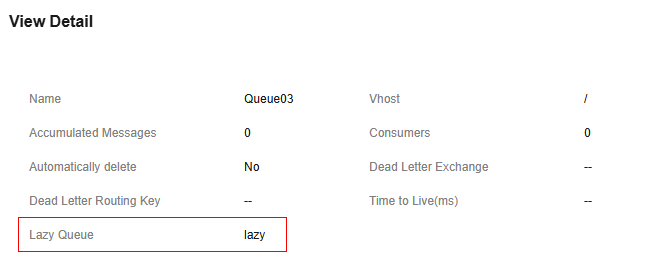Configuring Lazy Queues
By default, messages produced by RabbitMQ producers are stored in the memory. When the memory needs to be released, the messages will be paged out to the disk. Paging takes a long time, during which queues cannot process messages.
If production is too fast (for example during batch processing) or consumers cannot consume messages for a long time due to various reasons (for example when consumers are offline or broke down), a large number of messages will be stacked. Memory usage becomes high and paging is frequently triggered, which may affect message sending and receiving of other queues. In this case, you are advised to use lazy queues.
Lazy queues store as many messages to the disk as possible. Messages are loaded to the memory only when they are being consumed. This reduces memory consumption, but increases I/O and affects single-queue throughput. An important goal of lazy queues is to support long queues, that is, queues with many messages stored or stacked.
Lazy queues are recommended in the following scenarios:
- Messages may be stacked in queues.
- There is no high requirement on the queue performance (throughput), for example, less than 10,000 TPS.
- Stable production and consumption are desired, without being affected by memory changes.
Lazy queues are not suitable in the following scenarios:
- High RabbitMQ performance is expected.
- Queues are always short (with no messages stacked).
- The queue length limit is configured in a policy.
For more information about lazy queues, see Lazy Queues.
Notes and Constraints
Available for RabbitMQ 3.8.35 and later.
Configuring a Lazy Queue
A queue has two modes: default and lazy. The default mode is default.
If these methods are used, the configuration set by the policy takes precedence.
- Java client: Set the queue in a parameter when calling method channel.queueDeclare.
- RabbitMQ management UI: Set the queue using a policy.
- RabbitMQ console: Set the queue when creating a queue.
Map<String, Object> args = new HashMap<String, Object>();
args.put("x-queue-mode", "lazy");
channel.queueDeclare("myqueue", false, false, false, args);
- Log in to the RabbitMQ management UI.
- Click the Admin tab.
Figure 1 Admin tab page

- Choose Policies from the navigation pane.
- Add a policy.
Figure 2 Adding a policy

Table 1 Policy elements Parameter
Description
Virtual Host
Specify the virtual host. The slash (/) indicates the default virtual host.
Name
The policy name, which can be customized.
Pattern
Regular expression that defines the pattern for matching queues.
Apply to
Object to which the policy applies. Select Queues.
Priority
A larger value indicates a higher priority.
Definition
Configure lazy queues by setting queue-mode=lazy.
- Click Add/update policy.
The following figure shows a successfully added policy.
Figure 3 Viewing a lazy queue policy
- Create a queue by referring to Creating a RabbitMQ Queue and set Lazy Queue to lazy.
Figure 4 Creating a lazy queue

- In the queue list, click View Detail next to the created queue.
The lazy queue is created when Lazy Queue is lazy.
Figure 5 Viewing queue details
Related Document
To create a lazy queue by calling an API, see Creating a Queue.
Feedback
Was this page helpful?
Provide feedbackThank you very much for your feedback. We will continue working to improve the documentation.See the reply and handling status in My Cloud VOC.
For any further questions, feel free to contact us through the chatbot.
Chatbot





